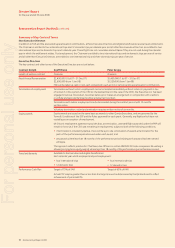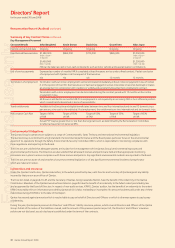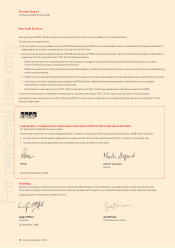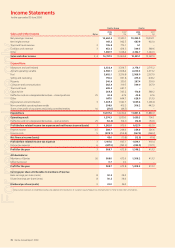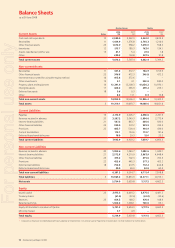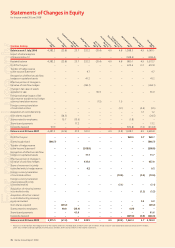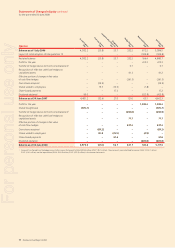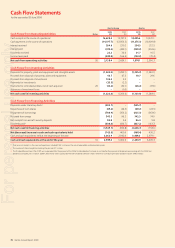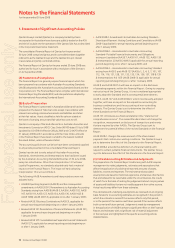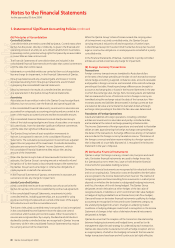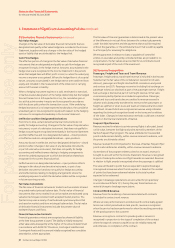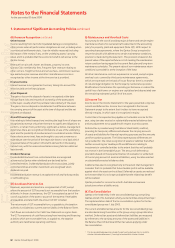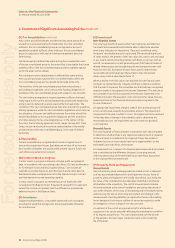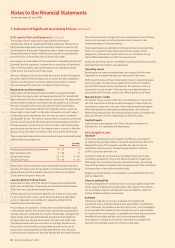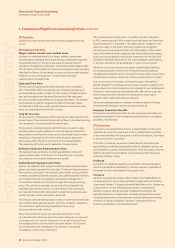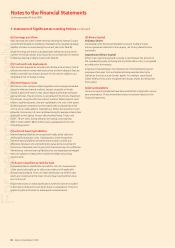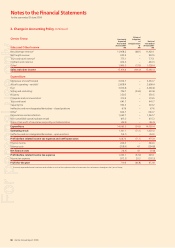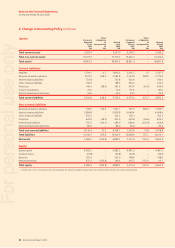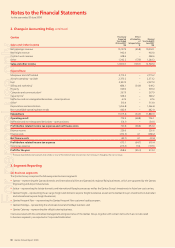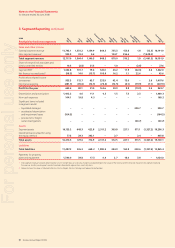Qantas 2008 Annual Report Download - page 83
Download and view the complete annual report
Please find page 83 of the 2008 Qantas annual report below. You can navigate through the pages in the report by either clicking on the pages listed below, or by using the keyword search tool below to find specific information within the annual report.
81 Qantas Annual Report 2008
(F) Derivative Financial Instruments continued
Fair Value Hedges
Changes in the fair value of derivative fi nancial instruments that are
designated and qualify as fair value hedges are recorded in the Income
Statement, together with any changes in the fair value of the hedged
asset or liability that are attributable to the hedged risk.
Cash Flow Hedges
The effective portion of changes in the fair value of derivative fi nancial
instruments that are designated and qualify as cash fl ow hedges are
recognised in equity in the hedge reserve. Amounts accumulated in the
hedge reserve are recognised in the Income Statement in the periods
when the hedged item will affect profi t or loss (i.e. when the underlying
income or expense is recognised). Where the hedged item is of a capital
nature, amounts accumulated in the hedge reserve are transferred from
equity and included in the measurement of the initial cost or carrying
amount of the asset or liability.
When a hedging instrument expires or is sold, terminated or exercised,
or Qantas revokes designation of the hedge relationship but the hedged
forecast transaction is still expected to occur, the cumulative gain or
loss at that point remains in equity and is recognised in accordance
with the above policy when the transaction occurs. If the underlying
hedged transaction is no longer expected to take place, the cumulative
unrealised gain or loss recognised in equity with respect to the hedging
instrument is recognised immediately in the Income Statement.
Ineffective and Non-Designated Derivatives
From time to time, certain derivative fi nancial instruments do not
qualify for hedge accounting. Changes in the fair value of any derivative
instrument, or part of a derivative instrument, that does not qualify for
hedge accounting are recognised immediately in the Income Statement
as either Ineffective and non-designated derivatives – closed positions
or Ineffective and non-designated derivatives – open positions.
Amounts shown in Ineffective and non-designated derivatives – closed
positions refl ect changes in fair value of any derivative instruments,
or part of a derivative instrument, that does not qualify for hedge
accounting and ineffectiveness relating to hedging arrangements
where the underlying exposure to which the derivative related was
recognised in the current fi nancial period.
Ineffective and non-designated derivatives – open positions refl ects
changes in fair value of any derivative instrument, or part of any
derivative instrument, that does not qualify for hedge accounting
and ineffectiveness relating to hedging arrangements where the
underlying exposure to which the derivative relates will be recognised
in future reporting periods.
Fair Value Calculations
The fair value of fi nancial instruments traded in active markets is based
on quoted market prices at balance date. The fair value of fi nancial
instruments that are not traded in an active market are estimated using
valuation techniques consistent with accepted market practice. The
Qantas Group uses a variety of methods and input assumptions that
are based on market conditions existing at balance date. The fair value
of derivative fi nancial instruments includes the present value of
estimated future cash fl ows.
Financial Guarantee Contracts
Financial guarantee contracts are recognised as a fi nancial liability
at the time the guarantee is issued. The liability is initially measured
at fair value and subsequently at the higher of the amount determined
in accordance with AASB 137 Provisions, Contingent Liabilities and
Contingent Assets and the amount initially recognised less cumulative
amortisation, where appropriate.
The fair value of fi nancial guarantees is determined as the present value
of the difference in net cash fl ows between the contractual payments
under the debt instrument and the payments that would be required
without the guarantee, or the estimated amount that would be payable
to a third party for assuming the obligations.
Where guarantees in relation to loans or payables of controlled
entities or associates and jointly controlled entities are provided for no
compensation, the fair values are accounted for as contributions and
recognised as part of the cost of the investment.
(G) Revenue Recognition
Passenger, Freight and Tours and Travel Revenue
Passenger, freight and tours and travel revenue is included in the Income
Statement at the fair value of the consideration received net of sales
discount, passenger and freight interline/IATA commission and goods
and services tax (GST). Passenger recoveries (including fuel surcharge on
passenger tickets) are disclosed as part of net passenger revenue. Freight
fuel surcharge is disclosed as part of net freight revenue. Other sales
commissions paid by Qantas are included in expenditure. Passenger,
freight and tours and travel sales are credited to revenue received in
advance and subsequently transferred to revenue when passengers or
freight are uplifted or when tours and travel air tickets and land content
are utilised. Unused tickets are recognised as revenue using estimates
regarding the timing of recognition based on the terms and conditions
of the ticket. Changes in these estimation methods could have a material
impact on the fi nancial statements of Qantas.
Frequent Flyer Revenue
Revenue received in relation to points earning fl ights is allocated, based
on fair value, between the fl ight and points earned by members of the
Qantas Frequent Flyer program. The value attributed to the awarded
points is deferred as a liability, within revenue received in advance, until
the points are ultimately utilised.
Revenue received from third parties for the issue of Qantas Frequent Flyer
points is also deferred as a liability, within revenue received in advance.
As members of the program redeem points for an award, revenue is
brought to account within the Income Statement. Revenue is recognised
at point of redemption where non-fl ight rewards are awarded. Revenue
in relation to fl ight awards is recognised when the passenger is uplifted.
The value attributed to points that are expected to expire (breakage)
is recognised as revenue when the risk expires i.e. based on the number
of points that have been redeemed relative to the total number
expected to be redeemed.
Changes in breakage expectations are accounted for prospectively
in accordance with Note 1(C). During the year, there has been no
material change to breakage expectations.
Contract Work Revenue
Revenue from the rendering of services associated with contracts
is included in contract work revenue.
Where services performed are in accordance with contractually agreed
terms over a short period and are task specifi c, revenue is recognised
when the service has been performed or when the resulting ownership
of the goods passes to the customer.
Revenue on long-term contracts to provide goods or services is
recognised in proportion to the stage of completion of the contract
when the stage of contract completion can be reliably measured
and otherwise on completion of the contract.
Notes to the Financial Statements
for the year ended 30 June 2008
1. Statement of Significant Accounting Policies continued
For personal use only


